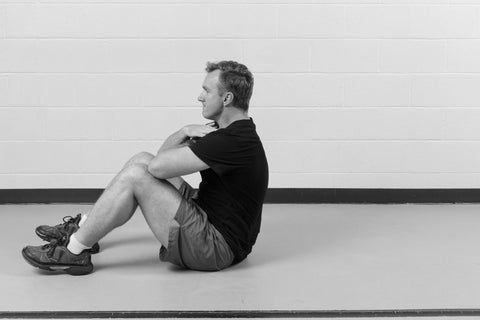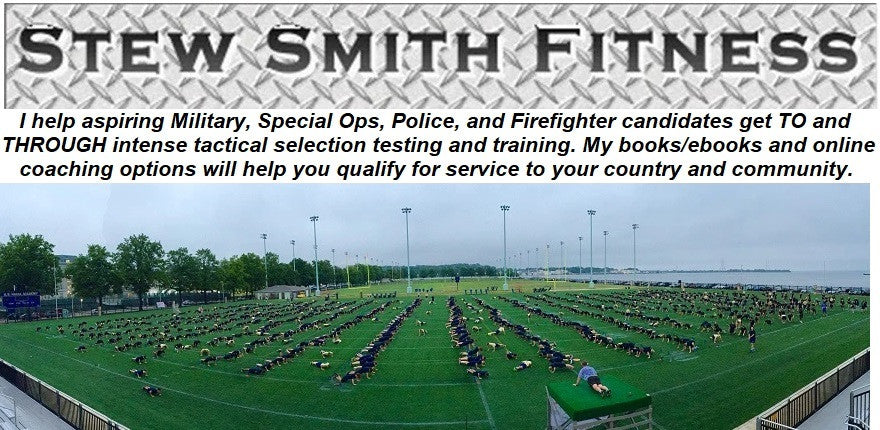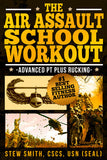The Candidate Fitness Assessment (CFA) Clinic
 US Naval Academy
US Naval Academy
The Candidate Fitness Assessment is the fitness test candidates for the Naval Academy, Military Academy, US Merchant Marine Academy, and the Air Force Academy must submit during the application process. For the full application process see the Admission's Department Pages for each Service Academy:
Military Academy (West Point) Admissions
US Merchant Marine Academy Admissions - Special NOTE: This Academy is one of the best kept secrets in my opinion. When you graduate from the USMMA, you have the opportunity to join any branch of service and do any job the military offers IF you qualify, or start a high paying career in the Merchant Marines. See podcast with USMMA graduate and Navy SEAL friend Adam LaReau.
This Article Focuses on HOW to Take the Test For Optimal Scores!
The Candidate Fitness Test is just one of many markers in the admissions process that can set you apart from other candidates. It is wise to practice not only this fitness test, but the future fitness test used by the service you select. by the way - 'Don't Train for This Test' At Your Own Risk!
See official Service Academy Website for directions, rest times, max scores for each event.
It is true that all three service academies have different fitness tests to prepare for during your candidate process. Once a cadet or midshipmen, you will take the following fitness tests every six months (each semester):
Navy - Cadence Pushups, Plank pose, 1.5 mile run
The fitness test at the Naval Academy is similar but a little different than the regular Navy PFA. Pushups, Plank and 1.5 mile run. But the Naval Academy is currently doing cadence pushups at a pace of 1 rep every 2 seconds.
If you select USMC, you will also need to ace the USMC PFT / CFT as you progress each year at the Naval Academy / Navy ROTC (USMC option):
PFT = Pullup, Plank, 3 mile run
CFT = Several Event Broken Up into Three Sections:
- Run 880 yards (two laps around a track), simulating movement to contact in battle dress uniform, fast.
- Lift a 30-pound ammunitions can overhead from shoulder height for max reps for two minutes.
- Perform a maneuver-under-fire simulated event, a timed 300-yard shuttle run in which Marines are paired up by size and perform the following tasks: sprints, agility course, high crawl, low crawl, body drag, fireman carry, ammo can carry, push-ups and grenade throw.
- Also the USMC Obstacle Course is a standard fitness element should you decide to go USMC option.

Army - You may see the APFT of Pushups, situps, and 2 mile run somewhere along your journey, but the new Army Combat Fitness Test is also a challenge in your near future:
Army CFT - 3RM Deadlift ; Standing Power Throw (20lb med ball); Hand-Release push-up; Sprint, Drag and Carry; Plank Pose (no more leg tuck); and two-mile run.
Air Force Academy Fitness Test - This test at the Academy is different from the Air Force in general. The USAFA fitness test is made up of pulllups, pushups, crunches, long jump, and 600yd run.
However, The Candidate Fitness Assessment HAS NOT Changed
Here is where some of the confusion comes from: The Candidate Fitness Assessment remains unchanged, but the Naval Academy and West Point has made changes to their fitness tests they take every semester once you are selected and attending the Academies. If you are looking at applying to the Service Academies - make sure you can ace the CFA - Candidate Fitness Assessment which consists of:
Kneeling Basketball Throw (3 min rest)
Pullups 2 minutes (3 min rest)
120 ft. Shuttle Run - (3 min rest)
Crunches 2 minutes (3 min rest)
Pullups max reps (5 min rest before the run - note transition tips below)
1 mile timed run - Complete (total time 40 min)
BUT - also make sure you start preparing for the Academy fitness test that will be administered soon after your arrival should you be accepted to attend.
 Picture from USNA Summer Seminar - You Will Take an Official CFA Here!
Picture from USNA Summer Seminar - You Will Take an Official CFA Here!
Check out Video of my Summer Seminar Workout!
There are TWO Phases of your preparation. You will have to ace the CFA get you TO the Academy, first. Then, the PFT or CFT gets you THROUGH the Academy's Physical Mission, second. You have spent so much effort getting TO the Academy, do not forget you will need to "up your game" in all areas (academic, physical, leadership, etc) in order to make it THROUGH the Academy.
Here is how to improve your scores on the CFA:
Take the CFA a few times and learn how to "take the test". This is not unlike the same strategy you had for the SAT / ACT. By practicing these tests you develop strategies that work for you but you will only know if they work if you actually practice the events in normal workouts and by taking the test every other week. But, you also must be training for the test for a few months for optiomal performance depending on your starting fitness levels.
Here are all the techniques you should consider when taking the test:
Be Fueled - Do not go into the test without having eaten during the day. You will burn all of your energy and likely have no fuel for the final running event if you do not have good foods and drinks prior to the test. Nothing fancy. Just normal food that you eat / drink prior to normal workouts or athletic events that work for you. NEVER try something new like highly caffeinated drinks or pre-workout to do better as you will not and likely be sick from introducing your stomach to new substances. Just go with natural carbs like fruits and sip on something like water or gatorade if you need the carbs. See ideas for the ABDs of Nutrition (After, Before, During Exercise)
Additional Podcast on Strategies for Nutrition for Testing and Long Days of Training. (LtCol Nick Barringer US Army, PhD Nutrition)
Warmup - Do a few minutes of jogging and loosening up your arms and legs prior to the events of the CFA. You do not want to go into this test having done no warmup.
Let's Break Down the CFA into Individual Events:
Kneeling Ball Throw - You will be tested on your "athletic potential" by throwing a basketball from your knees. You do need to practice this event a few times every upper body day per week (3-4 times / week) but only 3-5 throws a day. Also warmup your shoulder and torso prior to throwing for the test. Take a few practice throws of 50% effort to work on technique and proper 45 degree angle of the ball release. Throw from your torso and not just your arm and shoulder. On your knees this is difficult, but it can still be done as you just need to incorporate a bit of a twist to the throw as well. If you simply practice this throw a few times everyday, you will improve significantly.
120 ft. Shuttle Run - This is a fast event and will measure your speed and agility (ability to stop, turn around, and run again). The course is 4 x 30ft (10yds) runs done as fast as you can. In an event that is measured in seconds, you do not have time to move slowly. The best way to practice this event is get used to running and turning around (180 degrees) quickly during workouts.
The shuttle run is a full out sprint that requires you to stop and change direction as fast as you can. To get better at this agility drill, practice the shuttle run turn-around as well as the following exercises in this ebook for speed and strength:
Squats
Lunges
Jumps and Sprints
Practice the quick turn-around movement of the shuttle run as well during workouts. Add this quick test to the end of your workouts after being fully warmed up and your legs are ready for full speed activity. Remember this is 120 FEET not 120 YARDS.
Situps 2 minutes - Place your feet flat on the floor and raise your knees. It is best to start out with the heels of your feet about 12-18 inches from your rump.
Situps or curlups - Lie on your back with your arms crossed over your chest, keeping your knees slightly bent. Raise your upper body off the floor by flexing your abdominal muscles. Touch your elbows to your thighs and repeat. During the PFT, someone will be counting and holding your feet for you.

PACE YOURSELF: The most important thing is to pace your situps. Too many times people start out too fast and do about 30-40 in the first 30 seconds and not being able to get 30-40 in the next 1:30 in a 2:00 test. That tells me that you started out too fast. If your goal is 80-100 in a 2:00 period, you should pace yourself at 20-25 in 30 seconds and 40-50 in 1:00...etc.
Pushups 2 minutes - Two minutes of pushups is a standard military time limit for this exercise and you will see it again in future fitness tests throughout your military journey. Getting good at this test requires initial strength to do a pushup, then turning the strength exercise into an endurance / muscle stamina exercise by pushing your perceived limitations with higher volume (more reps) of pushups. Check out this article for Three of the Favorite Workouts to Help You Crush Pushups, Situps, and Pullups.
Pushup Stance - Your hands should be about shoulder width apart. Lie on the floor with your hands even with your chest and hands just outside shoulder width. Too many people place their hands too high or too low, which will weaken your push-ups tremendously. A 90 degree angle bend of the elbow is required or you can touch your chest to your partners fist who is counting your reps for you. If you have no partner, get a water bottle the size of a fist (3-4inches) off the floor to touch your chest on.

PS - if you ever start shaking uncontrollably during the final half minute of your pushup test, DO NOT try to get any more reps. When you are shaking you are wasting A LOT of energy that you will need for the remaining exercises of the test AND you will likely not even get 1-2 pushups once you start shaking. It is recommended to just fall on your chest / knees and your test is done.
Related Articles: Pushup Push Workout
Pullups max reps - If you build up and continue to practice pullups, you can perform well on pullup tests, BUT you have to practice them. These do not come naturally. Improving will takes practice doing pullups, negatives, pulldowns, rows, and other PULLING exercises to get better at pullups.

Grab the pull-up bar with your hands placed about shoulder width apart and your palms facing away from you. Pull yourself upward until your chin is over the bar and complete the exercise by slowly moving to the hanging position. Related article - Pullup Push Workout
5 MINUTE BREAK - Use it Wisely
The transition to the RUN: After you perform maximum repetition sets with your upper body muscles, your heart has forced blood to the arms, shoulders, and torso leaving you very “pumped up”. Running like this can be difficult because the heart has to now pump the blood from your arms and torso down to your legs and, of course, oxygenate the blood repetitively.
When blood is “stuck” in the upper body as it is after a maximum repetition PT test, your heart pumps harder than normal, which can throw off your normal pace (muscle memory) that you have trained to maintain for your run. Your breathing is more rapid, your heartbeat is therefore more rapid, your arms swing is more stiff than fluid and relaxed, and your legs are burning for oxygenated blood. This will leave many to say at the end of the run, “I felt OK after the first two laps, but the first half mile about killed me.”
Here is the answer to this problem: Train for the Transition
After you perform the PT section of the test, take the time in between the upper body exercises to stretch the arms, chest, shoulders, stomach and lower back. Then run for about 2 minutes at an easy pace to get the blood down toward your legs. Finally, take about 2-3 minutes of the 5 minute "rest time" to stretch your legs. Keep shaking the arms, throughout the time in between the PT and run, to loosen up.
1 mile timed run - Focus on PACE with the 1 mile run, but since it is only 1 mile, you can push yourself and go faster as this is NOT considered a long slow distance run. After the PT portions of the test, usually the run turns into a gut check. I find that having sipped some Gatorade or had some extra sugar in my body will help with that final push of energy needed to go anaerobic in the run for the best time. After you have transitioned from the PT portion, focus on steady running pace, inhales/exhales, and arm swings to work through the next 1 miles of running. If done in the heat, make sure you have properly hydrated prior to the CFA, but also sipped enough water / electrolytes / sugar so you are at your best.
The Service Academy Candidate Fitness Assessment HAS NOT CHANGED
If you've ever wondered "Can getting better at the CFA help my application?" The answer is yes. The Service Academy Workout – Military Officer Fitness Candidate Fitness Assessment Workout book or ebook created by Naval Academy Graduate Stew Smith - Former Navy SEAL - has the answers every service academy candidate needs to know about fitness training and preparing for the CFA as well as harder programs for Special Ops candidates and Marines.
To Help Prepare for Future Fitness Tests Consider the following depending on the service academy you are attending.
(Getting THROUGH the Academy):
USMC Options for Naval Academy Graduates (ROTC too)


Navy SEAL and EOD is an Option After Graduation Too:
(See from Plebe to Navy SEAL article)
Army Fitness Options (PFT, CFT, Airborne, Air Assault School, etc)

Who Is The Tactical Fitness Coach / Author Stew Smith?
 |
I'm the former Navy SEAL that military recruits and special ops candidates go to for books, ebooks and online coaching to prepare themselves to get to and through intense tactical assessment and selection programs and qualify for service in their chosen tactical profession. See More at StewSmithFitness.com |
Check out the Complete List of Training Programs (Spec Ops, Military, Police, Fire)
Other Traning Programs focus on Seasonal Tactical Fitness Periodization Models of training. These programs as well as my online coaching programs have Winter Lift Cycles in them as part of our Seasonal Tactical Fitness Periodization System. But, do not get these lift cycles confused with ACTUAL strength / power lifting programs, these are strength / power programs that also have a focus on cardio fitness maintenance BECAUSE you need to be good at all the elements of fitness and develop into an all-round Tactical Athlete.
Get Weekly Unpublished Workouts Tested and Evaluated by local Stew Smith Training programs.
New Tactical Fitness Training Course!
Getting TO the training does not guarantee you get THROUGH the training. Learn about the two phases of tactical fitness you need to develop thoroughly before getting to BUDS. Check out the Online Course - Getting TO and THROUGH Special Ops Selection.
If You Need a More Personalized Approach to Fit Your Needs, Goals, Time per Day, Days per week, Facilities, Abilities, etc...Try Online Coaching
Questions? Just email me at Stew@StewSmith.com
At StewSmith.com - List of Products and Services
- FREE Articles
- Podcasts and Swimming Videos at Youtube.com page
- eBooks
- Books and eBooks in PRINT
- Stew Smith Fitness Club membership site
- Online Coaching















